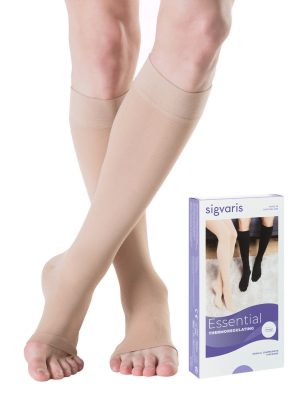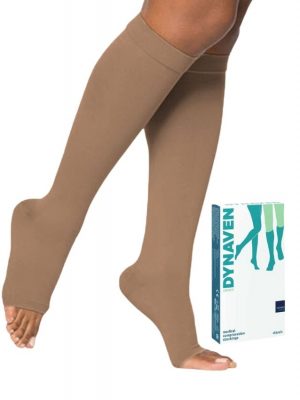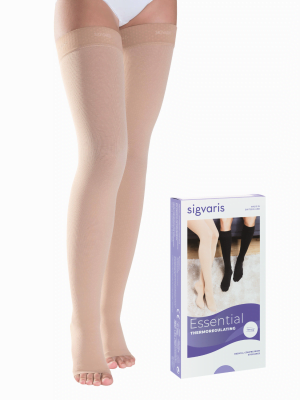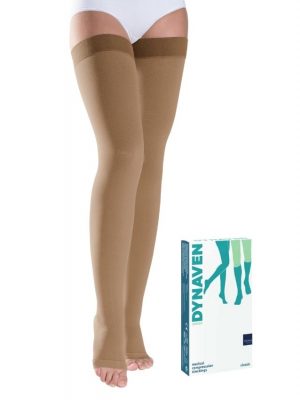DVT Compression Stockings
What is DVT?
Deep Vein Thrombosis, also known as DVT, is a serious medical condition that can progress over time. Early diagnosis of this condition can help prevent serious complications. DVT occurs when blood clots are formed in veins located deep inside your body. The most common body parts where these blood clots can appear are the lower legs or thighs.
Deep vein thrombosis is a condition that can happen to anyone and can result in serious complications and even disabilities. The most serious cases, if neglected, can even lead to the patient’s death.
One of the most common DVT treatments for this medical condition is using DVT compression stockings. Depending on the seriousness of your situation, you may require surgery or a longer duration with medicines and DVT stockings.
Compression Stockings for DVT Price
|
Sr. No. |
Sigvaris Stockings for DVT |
Price |
|---|---|---|
| 1 | Class 1 Compression – Below Knee Length – Sigvaris Cotton | ₹ 5,490.00 |
| 2 | Class 1 Compression – Below Knee length – Sigvaris Top Fine Select | ₹ 3,290.00 |
| 3 | Class 1 Compression – Thigh Length – Sigvaris Cotton | ₹ 9,390.00 |
| 4 | Class 2 Compression – Below Knee Length – Sigvaris Top Fine Select | ₹ 3,290.00 |
| 5 | Class 2 Compression – Thigh Length – Sigvaris Cotton | ₹ 9,390.00 |
| 6 | Class 2 Compression – Thigh length – Sigvaris Top Fine Select | ₹ 5,390.00 |
| 7 | Class 2 Compression Below Knee Length – Sigvaris Cotton | ₹ 5,490.00 |
What Causes Deep Vein Thrombosis?
While DVT is a condition that starts with damaged veins, it is important to get to the root of the problem before you try to find the appropriate treatment. This is because multiple factors can cause deep vein thrombosis, the most common ones being:
- Progressing age: Like many other illnesses, the risk of developing DVT increases with age.
- Genetic condition: If your family has a medical history of DVT, then you are more likely to develop blood clots.
- Injuries in the past: If you have had any deep injuries, those can develop into DVT if neglected.
- Pregnancy: During pregnancy, the pressure on the veins in your legs and pelvis increases, which can cause blood clots in those areas.
- Major illnesses: Certain cancers and heart diseases can lead to forming blood clots in your limbs, leading to DVT.
What are the symptoms of Deep Vein Thrombosis?
Similar to how the causes of DVT differ, so do the symptoms. First, it is important to understand that about 50 per cent of the time, deep vein thrombosis is diagnosed in patients without showing any symptoms.
So when there are symptoms of DVT, they usually include:
- Swelling in your legs
- Cramping, unexplained pain
- Part of the skin becomes warmer than the rest of the body
- Changes in skin colour
How To Choose Compression Stockings For DVT?
While DVT is a serious medical condition, it is treatable. So consult your doctor if you are experiencing any common DVT symptoms. You will be prescribed some medications along with medical-grade deep vein thrombosis compression stockings.
Depending on the severity of your condition, you may need different compression levels in DVT stockings. This is because the levels or classes in these stockings indicate different levels of tightness. You don’t need to worry about choosing between levels as this is a decision made by your doctor.
After the compression class you require, the doctor will specify the length of the stockings. Depending upon where your blood clot has occurred, the doctor will choose between knee length or thigh length stockings.
The next step would be to decide the fabric and size of the stockings. You can choose between sigvaris cotton stockings, synthetic and natural rubber blends. While this does not affect the compression quality, it will influence the comfort and experience of wearing the garment.
The size is also important while buying compression stockings for DVT. The size will ensure correct fit and precise compression. Each product line has its own sizing chart so make sure you select the correct size based on your leg measurements. If you need help with sizing, contact customer support for assistance.
Frequently Asked Questions
How long do you keep DVT stockings on?
Ideally, compression stockings should be worn in the morning and taken off before bedtime.
However, your doctor understands your condition best, therefore follow their advice on how long you need to wear DVT compression stockings every day.
When would you use DVT stockings?
Deep vein thrombosis can lead to severe health issues. You can start wearing compression stockings at the first symptom of DVT. Additionally, it is also advised to wear these stockings post-surgery until your legs become more accustomed to moving.
What should you not do with a DVT?
If you get diagnosed with deep vein thrombosis, these are the things you should not do:
- Don’t stand in one spot for extended periods of time
- Don’t wear clothes that restrict blood flow to your legs
- Don’t smoke
- Don’t participate in rough sports
How can I dissolve a blood clot in my leg naturally?
You cannot actually dissolve blood clots in your legs naturally, but doctors suggest regular use of DVT Socks can reduce your blood clots over time.
Using compression stockings also ensures that you are preventing new blood clots from forming in your legs.
Why do patients with DVT need bed rest?
If ignored, deep vein thrombosis can lead to severe pulmonary embolism events. DVT patients are put on bed rest as part of their treatment to prevent the condition from worsening.





